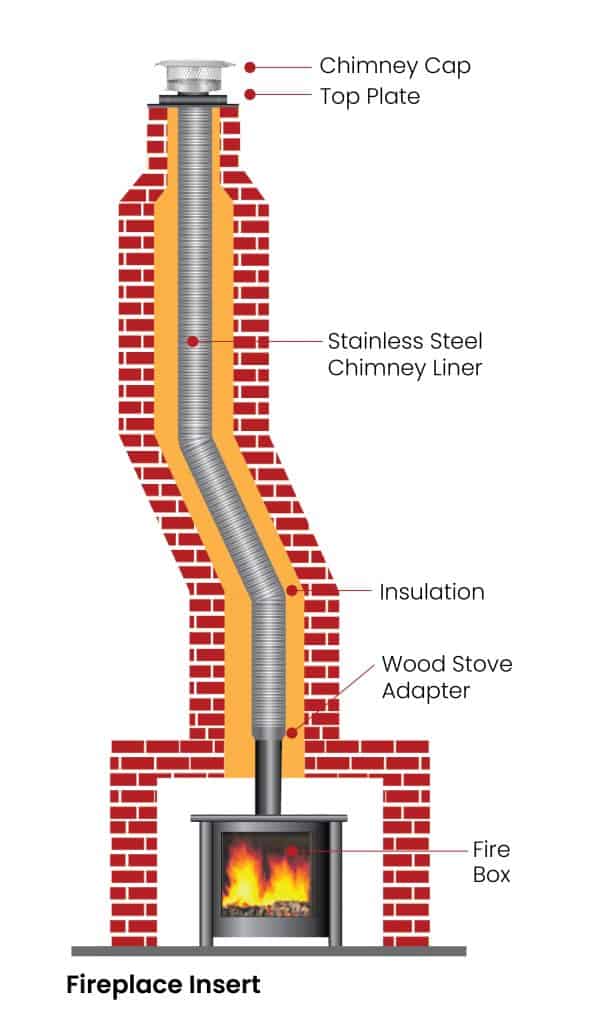Table Of Content

If you want to have a wood-burning stove as a heat source, you will need to make sure that you connect it to a proper wood-burning stove chimney. An air insulated chimney is designed to minimize the airflow through the vent by trapping air between its metal layers. One disadvantage to masonry though is, that because of the material they are made out of, it can be very heavy. A typical masonry chimney will weigh around 6 to 7 tons and could put a strain on your home’s foundation.
Base Plate of Steel Chimney
Since hot air is “trapped” within the stack walls, it allows the heat to be radiated back through the vent and into the room. This means that there will be prefab products that are sure to fit your overall home design. Masonry chimneys are also considered quaint and charming, so having a nice masonry smokestack sticking out of your roof often adds to the aesthetic appeal of your home and will increase its resale value. While the chimney starts inside a building, it typically protrudes up and out of a building’s roof. Installing a stainless steel chimney liner or an aluminum chimney liner is an easy way to repair a damaged chimney flue. In other words, draft is simply the natural movement of gases up your chimney as your heating unit draws fresh air into the appliance.
Quick Tip: Detect Air Leaks for Only $1
Does your home lack a chimney, or is the existing one in dire need of an upgrade? Chimneys aren’t just functional elements in a home; they add character and warmth. Whether you’re building a new chimney or renovating an existing one, this guide will walk you through the process, helping you master the art of chimney construction for a successful home renovation.

Types of Chimney Designs
Therefore, chimney height needs to be a minimum of 3 feet above flat roofs and at least 2 feet above the roof ridge or any raised portion of the roof within 10 feet. If you don't feel comfortable with the project, sometimes it pays to just hire a professional who builds chimneys for a living. The very first thing you need to do before even beginning on your project is to make sure that all of your measurements and materials are ready to go.

So, your heating system and chimney rely on each other for optimal performance.
Steel Plates for Chimney
A fireplace surround is similar to the faceof a fireplace, but is usually more of a decorative feature. It can be foundaround the opening of a fireplace, but isn’t always found as a non-combustiblematerial like the face of a fireplace. We have two open fireplaces in our home,and one of the hearths is made from granite, while the other hearth is madefrom concrete. The hearth inside the firebox can sometimesbe referred to as the inner hearth, while the platform that extends out intothe room can be referred to as the outer hearth. The outer hearth helps protectthe room from any hot embers that spit from the fire, and a screen can beplaced on the outer hearth to further prevent anything hot from getting intothe room.
A Guide to Chimneys
The second type of prefabricated chimneys are made from heavier materials, popularly clay or concrete block with insulation sandwiched in between two layers of cement mortar. There is no interior liner for this kind—just the insulating material and a facing. These types may also need some cutting down depending on your area but usually only at the top where it attaches into the framing studs above. You can buy adjustable flue liners for these types of prefab chimneys. Chimneys are commonly made from brick but other materials such as steel may sometimes be used depending on the application.
How to build a Brick Chimney Stack?
For a typical six-foot high stack, the base should be around three feet square. Dig a hole in the centre of the base large enough to accommodate the flue pipe. They also come in different sizes so you can choose one depending on how big your home is. The stack will definitely be visible from the outside of your house so it’s important to make sure you get one that looks good and matches the style of your home.
Space-saving chimney design for compact kitchens:
Similarly to the hearth and firebox, it’salso made from a non-combustible material. The face of our living room fireplaceis made from concrete; the same material used for the hearth. At the base of the firebox is the hearth,and at the top of the firebox is the throat of the chimney, where a damper canbe found in some fireplaces. Fireplaces come in different sizes, shapesand designs, and so I’ve put together this fireplace components guide toexplain the different parts of a fireplace and chimney that can be found inyour home.
These Fireplace Ideas Are Bound to Give Your Room Some Spark - ELLE Decor
These Fireplace Ideas Are Bound to Give Your Room Some Spark.
Posted: Fri, 13 Oct 2023 07:00:00 GMT [source]
Whether traditional or prefabricated, all chimneys are fitted with a damper—that is, a moveable metal plate. When open, the damper allows smoke from the fireplace (along with heat and harmful gases, such as carbon monoxide) to exit the house. During the summer or on cold winter nights when you are not using the fireplace, the damper closes in order to help maintain a comfortable indoor temperature.
This type of stove then needs to be connected so that the flow of smoke and gases is directed through the masonry smokestack. Rising heat creates an air current that carries heat, smoke, and toxic gases with it along an upward trajectory. Known as drafting, this fundamental principle of convection prevents your house from filling with smoke and hazardous exhaust. Larger flues create stronger drafts, generally speaking, but in any case, eliminating creosote deposits and other clogs ultimately safeguards against chimney problems.
The lintel is located at the top of thefirebox, between the throat of the chimney and the fireplace surround. Its mainpurpose is structural, and helps spread the load of the chimneybreast acrossthe sides of the fireplace. The mantel provides a shelf on whichdecorations and other items can be placed, but can sometimes help with preventingsmoke from the fire from coming into the room.
For cutting bricks you will require an angle grinder with diamond blades as well as a wet saw if you don't have one already. You can find more information on the tools required for building a brick chimney stack online. It’s not just the physical labor that needs to be done, but also the knowledge required to ensure it is done correctly. This blog post will guide you through every step of building your own chimney, from choosing materials to installing your final chimney cap. A fireplace insert is a special type of wood stove that is designed to fit into an existing masonry fireplace.

No comments:
Post a Comment